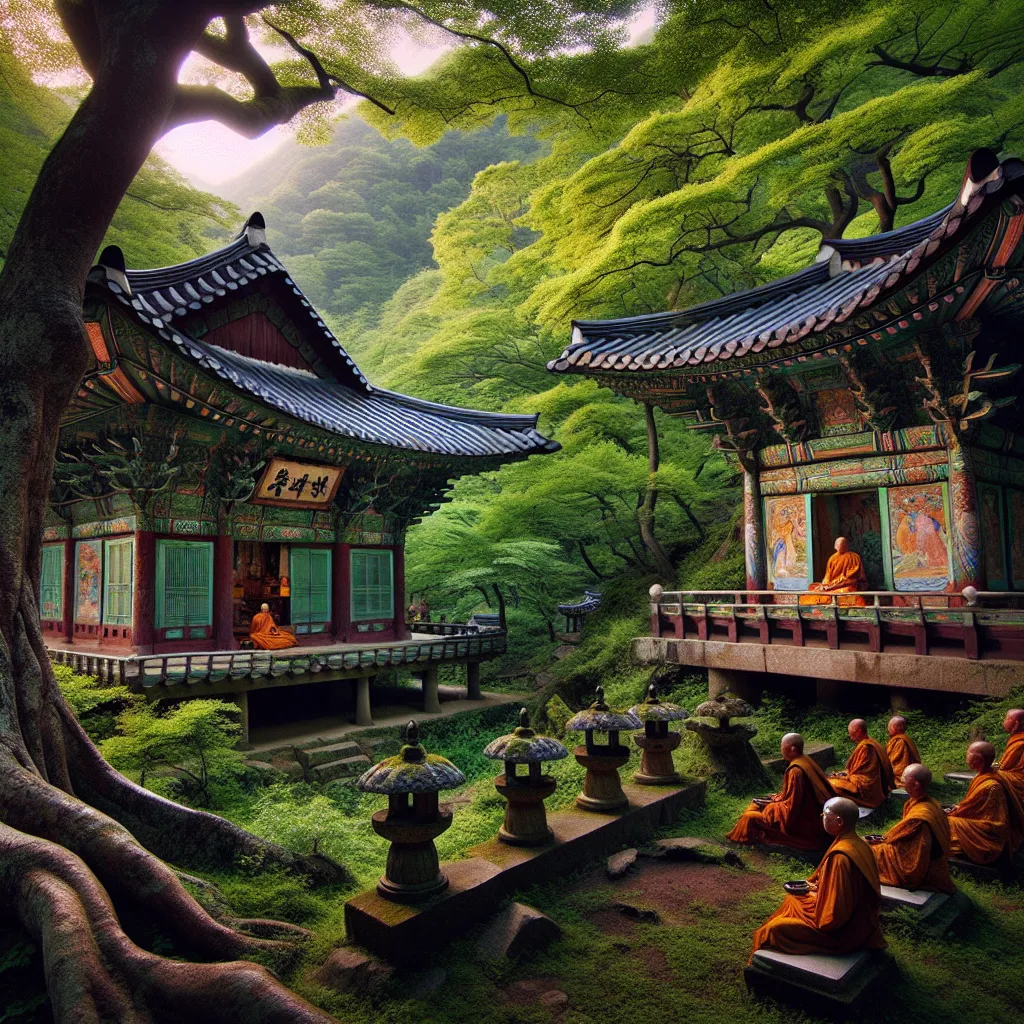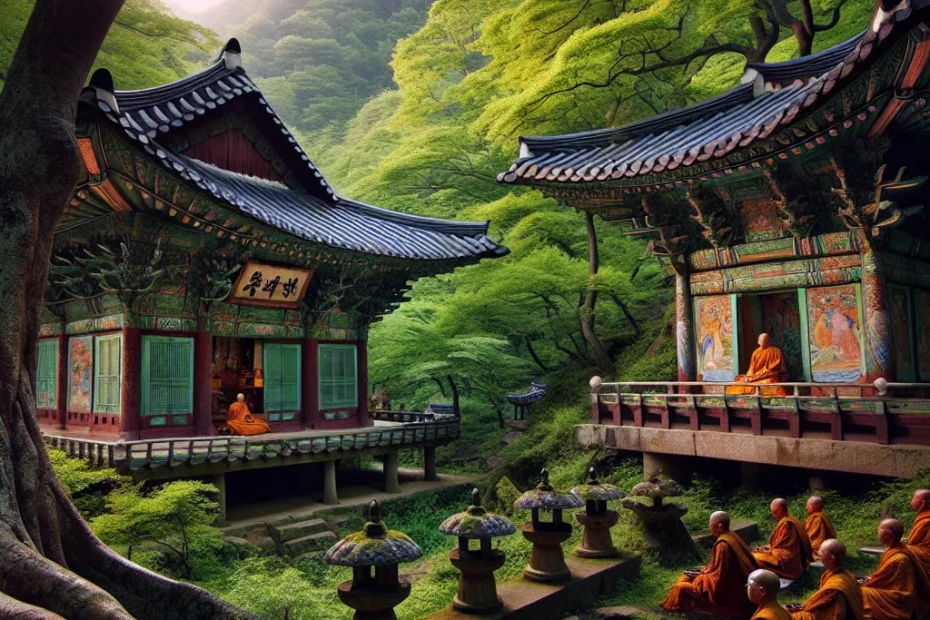Korean Buddhism has left a profound mark on Korea’s spiritual landscape, shaping its culture and heritage for centuries. Exploring the origins of Korean Buddhism reveals a rich tapestry of traditions and beliefs that have endured through the ages. Understanding the influence of Korean Buddhism on Korean culture sheds light on the deep-rooted connections between religion and society in Korea. Examining the architecture of Korean Buddhist temples unveils a harmonious blend of aesthetics and spirituality, showcasing the intricate craftsmanship and devotion of its followers. Discovering the practice of Seon meditation in Korean Buddhism offers a glimpse into the profound spiritual journey undertaken by practitioners. As we delve into the enduring legacy of Korean Buddhism, we uncover a treasure trove of wisdom and enlightenment that continues to inspire and guide generations.

Exploring the Origins of Korean Buddhism
In delving into the rich tapestry of Korean Buddhism, it is essential to explore its origins, which date back over a millennium. The roots of Korean Buddhism can be traced to the early centuries of the Common Era when the teachings of the Buddha first made their way to the Korean peninsula from China. 🌿
The Three Kingdoms Period
During the Three Kingdoms period (57 BCE – 668 CE), Buddhism began to take root in Korea, gaining significant influence and patronage from the ruling elite. The introduction of Buddhism to Korea is attributed to the efforts of missionaries and scholars who traveled along the Silk Road, bringing with them sacred texts and Buddhist artifacts. 📜
The Hwaeom School
One of the pivotal moments in the history of Korean Buddhism was the establishment of the Hwaeom (화엄) school during the Unified Silla period (668–935 CE). This school, based on the Avatamsaka Sutra, emphasized the interconnection of all phenomena and the concept of mutual interpenetration. The Hwaeom school played a crucial role in shaping the development of Korean Buddhism and fostering a unique Korean Buddhist identity. 🏯
The Introduction of Seon Buddhism
Another significant development was the introduction of Seon (선) Buddhism to Korea during the Goryeo dynasty (918–1392 CE). Seon, known as Zen in Japan and Chan in China, focused on meditation practice as a means to attain enlightenment. The teachings of Seon masters such as Jinul and Taego brought a renewed emphasis on direct experience and the transmission of the Dharma outside of scriptures. 🧘♂️
Flourishing During the Joseon Dynasty
Korean Buddhism continued to flourish during the Joseon dynasty (1392–1910 CE), despite facing periods of suppression and revival. Monasteries such as Haeinsa, Bulguksa, and Tongdosa were established as centers of Buddhist practice and learning, preserving invaluable Buddhist scriptures and artifacts. The Joseon era also saw the rise of prominent Buddhist scholars and reformers who sought to revitalize the practice of Buddhism in Korea. 🏞️
Today, Korean Buddhism remains a vibrant and integral part of Korean culture and society, with millions of adherents and numerous temples spread across the country. The teachings of Korean Buddhism continue to inspire and guide individuals on their spiritual journey, offering profound insights into the nature of existence and the path to awakening. 🌸
In exploring the origins of Korean Buddhism, we gain a deeper appreciation for the enduring legacy of this ancient tradition and the profound impact it has had on shaping the spiritual landscape of Korea. 🌟
As we continue to unravel the intricate threads of Korean Buddhism’s history, we are reminded of the wisdom and compassion that have flowed through its teachings for centuries, enriching the lives of countless individuals and illuminating the path to enlightenment. 🌌
Understanding the Influence of Korean Buddhism on Korean Culture
Korean Buddhism stands as a cornerstone of Korea’s rich cultural heritage, shaping the country’s identity and values for over a millennium. With a history dating back to the 4th century, Korean Buddhism has left an indelible mark on various aspects of Korean society, from art and architecture to literature and philosophy. 🌟
The Influence on Korean Architectural Landscape
One of the most striking influences of Korean Buddhism on Korean culture can be seen in the country’s architectural landscape. Temples such as Bulguksa and Haeinsa, designated as UNESCO World Heritage sites, showcase the exquisite craftsmanship and spiritual devotion that define Korean Buddhist architecture. The intricate wooden carvings, colorful paintings, and serene garden settings of these temples reflect the deep spiritual connection between Korean Buddhism and nature. 🏯
Impact on Korean Art and Aesthetics
Moreover, Korean Buddhism has played a pivotal role in shaping Korean art and aesthetics. The art of Buddhist sculpture, exemplified by masterpieces like the Seokguram Grotto, highlights the skill and creativity of Korean artisans. These sculptures, characterized by their graceful lines and serene expressions, embody the Buddhist principles of compassion and enlightenment. 🎨
Influence on Korean Literature and Philosophy
In addition to its artistic contributions, Korean Buddhism has profoundly influenced Korean literature and philosophy. The Tripitaka Koreana, a collection of Buddhist scriptures carved onto wooden blocks, is a testament to the intellectual achievements of Korean monks. This monumental work not only preserved Buddhist teachings but also fostered a culture of scholarship and learning in Korea. 📚
Legacy on Korean Society
Furthermore, Korean Buddhism has left an enduring legacy on Korean society by promoting values of compassion, harmony, and mindfulness. The practice of Seon (Zen) meditation, introduced to Korea by the great monk Jinul, has been instrumental in cultivating inner peace and self-awareness among Koreans. The emphasis on mindfulness and self-reflection in Korean Buddhism has helped individuals navigate the complexities of modern life with grace and resilience. ☯️
In conclusion, the influence of Korean Buddhism on Korean culture is profound and multifaceted. From architecture and art to literature and philosophy, Korean Buddhism has shaped the spiritual landscape of Korea and continues to inspire generations of Koreans to seek enlightenment and inner peace. The enduring legacy of Korean Buddhism serves as a reminder of the timeless wisdom and profound insights that this ancient tradition offers to the world. 🌸
Examining the Architecture of Korean Buddhist Temples
As we delve into the intricate world of Korean Buddhist temples, we are met with a rich tapestry of architectural marvels that have withstood the test of time. These temples, known as “Jongga,” are not just places of worship, but also serve as repositories of Korea’s spiritual and cultural heritage. 🏯
The Use of Traditional Korean Roof Tiles
One of the defining features of Korean Buddhist temple architecture is the use of traditional Korean roof tiles, known as “giwa.” These curved roof tiles, with their unique overhanging eaves, not only protect the structures from the elements but also lend a sense of elegance and grace to the temple buildings. The upward-curving eaves symbolize the hands of the Buddha reaching out to embrace and protect the worshippers. 🙏
The Intricate Woodwork
Another striking aspect of Korean temple architecture is the intricate woodwork found in the construction of the temple buildings. The use of interlocking wooden brackets, known as “dancheong,” not only provides structural support but also serves as a form of artistic expression. These colorful patterns and designs, often featuring motifs of lotus flowers and dragons, add a vibrant touch to the temple structures, creating a visual feast for the eyes. 🌸🐉
Unique Layout and Design
Korean Buddhist temples are also characterized by their unique layout and design. The main hall, or “Daeungjeon,” houses the main Buddha statue and is considered the most sacred space within the temple complex. Surrounding the main hall are various auxiliary buildings such as the lecture hall, library, and meditation halls, each serving a specific function in the daily life of the temple community. The layout of the temple complex is often designed to harmonize with the natural surroundings, creating a sense of peace and tranquility for both worshippers and visitors alike. 🌿🕊️
Beautiful Gardens and Outdoor Spaces
In addition to the architectural elements, Korean Buddhist temples are also known for their beautiful gardens and outdoor spaces. These meticulously landscaped gardens, often featuring lotus ponds, stone pagodas, and winding pathways, are designed to evoke a sense of serenity and contemplation. The sound of water trickling from a nearby stream, the rustling of leaves in the gentle breeze, all contribute to the overall atmosphere of harmony and balance within the temple grounds. 🌳💧
In conclusion, the architecture of Korean Buddhist temples is a testament to the enduring legacy of Korea’s spiritual heritage. From the graceful roof tiles to the intricate woodwork and serene garden spaces, each element is carefully crafted to create a holistic environment that nurtures the body, mind, and spirit. Visiting a Korean Buddhist temple is not just a journey through physical space but a spiritual odyssey that connects us to the timeless wisdom and beauty of Korea’s cultural traditions. 🌟🇰🇷
Discovering the Practice of Seon Meditation in Korean Buddhism
Embark on a journey to uncover the profound practice of Seon meditation deeply rooted in Korean Buddhism, a spiritual tradition that has endured for centuries. 🌿
The Origins of Seon Meditation
Seon meditation, known as Zen in Japanese Buddhism, is a form of meditation that emphasizes direct experience and insight into one’s true nature. In Korean Buddhism, Seon meditation is considered a cornerstone of practice, leading practitioners on the path to enlightenment. 🧘♂️
The Evolution of Seon Meditation
The origins of Seon meditation can be traced back to the teachings of the legendary Indian monk Bodhidharma, who brought the practice to China in the 6th century. From there, it made its way to Korea, where it flourished and evolved into the unique form of Seon meditation we see today. 🌟
The Role of Koans in Seon Meditation
One of the distinctive features of Seon meditation is the use of ‘Koan,’ which are paradoxical questions or statements designed to provoke deep contemplation and insight. By grappling with these Koans, practitioners aim to transcend the limitations of conventional thinking and experience a direct realization of their true nature. 🤔💡
Seon Meditation Retreats
In Korean temples and monasteries, Seon meditation retreats are held regularly, offering practitioners the opportunity to immerse themselves in intensive meditation practice under the guidance of experienced teachers. These retreats often last for several days or even weeks, providing a supportive environment for deepening one’s practice and cultivating mindfulness. 🏞️🙏
The Benefits of Seon Meditation
The benefits of Seon meditation are manifold, ranging from stress reduction and improved focus to a profound sense of inner peace and spiritual awakening. Through regular practice, practitioners can cultivate a sense of presence and awareness that extends beyond the meditation cushion into their daily lives. 🌌
Embracing the Transformative Power of Seon Meditation
As we delve into the practice of Seon meditation in Korean Buddhism, we uncover a rich tradition that continues to inspire and guide spiritual seekers on the path to awakening. Let us embrace the transformative power of Seon meditation and discover the profound wisdom it holds for all who seek inner peace and enlightenment. 🌸🙌
In Conclusion
In conclusion, the practice of Seon meditation in Korean Buddhism offers a transformative journey of self-discovery and spiritual growth, inviting practitioners to explore the depths of their own minds and awaken to the true nature of reality. Let us embrace this ancient practice with open hearts and minds, knowing that the path to enlightenment is always within reach. 🌈🌺
In conclusion, the enduring legacy of Korean Buddhism stands as a testament to Korea’s rich spiritual heritage. From its ancient origins to its profound influence on Korean culture, Korean Buddhism has left an indelible mark on the country. The magnificent architecture of Korean Buddhist temples and the profound practice of Seon meditation further showcase the depth and beauty of this tradition. As we explore the depths of Korean Buddhism, we are reminded of the wisdom and tranquility it offers, enriching not only the lives of Koreans but also resonating with spiritual seekers worldwide. The legacy of Korean Buddhism continues to inspire and guide, offering a profound path to inner peace and enlightenment.
